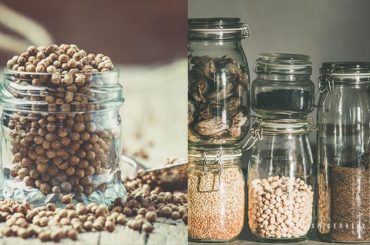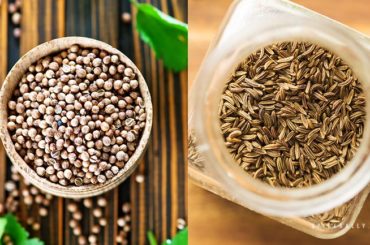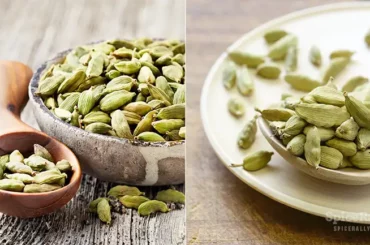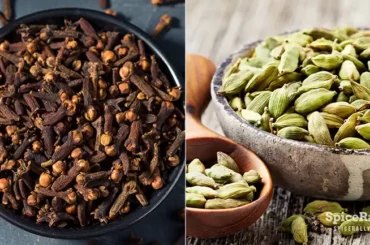Whenever you need to cook something for your family or loved ones, there are many things that you usually consider. You would always try to make the dish that comes from you very flavorful, healthy, and visually appealing. And, in the truest meaning of the term, coriander, also called cilantro, is both a spice and herb.
This would help you cover up all the details of the dish you come up with. This spice embellishes your meal, adding flavor and aroma to each and every bite you have.
Coriander is an annual plant that grows fastly. Most of this plant- the leaves, stalks, and seeds are used for human consumption. It can also be considered a plant that acts both as a spice and a herb in the culinary world.
So, we, in fact, have plenty of things to share with you about this remarkable flavoring. Scroll down this article to get every bit of knowledge that you want to obtain about coriander, its uses, and many more exciting, unfamiliar facts.
What Is Coriander?
Coriander (Coriandrum sativum) is an annual plant that bears an intimate resemblance to parsley. And interestingly, it is from the same plant family (Apiaceae) as parsley. It is also called Chinese parsley, cilantro, and Dhaniya (in India).
The name coriander is said to be derived from “koris”, the Greek term for “bedbug”. This is because the smell of the plant is very similar to the scent of this animal.

This spice is actually an exciting element of the culinary world. And, one reason we say this is with regard to the different names it is recognized.
When it comes to the USA, they call the leaves and stalks of this plant “Cilantro” and seeds “coriander seeds”. In the meantime, countries apart from the USA call the seeds “coriander seeds” and the leaves and stalk “coriander”.
The second interesting fact is that while coriander seeds come to the spice category, coriander leaves fall under the umbrella of herbs. Therefore, this plant is basically a two-in-one.
The coriander leaves or cilantro are feathery, light green, and flat in appearance. And, although it resembles parsley, the distinct flavor of cilantro leaves is pretty different from that of parsley.
However, cilantro has a comparable growth pattern to parsley. But, it does not react agreeably to multiple yields.
Accordingly, this is a culinary herb and also a spice that is broadly used by Indian, Mexican, Latin, and Spanish cuisines. Some countries also use coriander as folk medicine to treat many health conditions. Coriander roots are employed mainly in Vietnamese and Thai cooking, featured in most of their dishes.
A Quick Peek To The History Of Coriander
There is actually no proper source that states the origin of this spice. However, Southern Europe and Western Asia show leading cultivation of this plant. But, some research also suggests that Portugal and Israel also could be the ancestors of coriander. Anyway, so far, the exact origin of this plant has not yet been found.
In addition, as one of the oldest identified herbs, it was grown in archaic Egyptian gardens. And its seeds have been discovered in Egyptian tombs.
It has been grown for many years in India and China. According to the data, the Spanish rulers have introduced coriander into Mexico and Peru. Moreover, the Chinese have employed the herb in portions to deliver divinity. Sources also say that coriander was regarded as an aphrodisiac or appetite stimulus in other civilizations.
The seeds were used as a medicine to make tea. This tea has been used as digestive support and for its admirable sedative impact on some people.
The oil from the seeds was used to camouflage the flavors of other medicines used in ointments for painful rheumatic joints and muscles. And it is marked to have cholesterol-lowering effects.
What Is Coriander Used For?
Coriander is basically a culinary herb and a spice. But, it is also used for multiple medicinal purposes. However, all the visible parts of the plants are edible. And, the leaves, stalks, and seeds are the mainly employed parts of the plant for culinary or medicinal purposes.
The uses of this plant depend and vary on the part of the plant used. The fatty and essential oils of the fruits are both employed for commercial objectives. And they are used either individually or integrated. After extracting the essential oil, the fatty oil acquired from the extraction remains either by pressing or by extraction.
The ripe fruit of the coriander plant is dried and then used as a spice. This is what we use in most of our cooking as coriander seeds. Coriander seeds are helpful in multiple ways when cooking. And, they flavor savory dishes as well as baked goods and are also used as tea.
Meanwhile, coriander leaves and stalks, or cilantro, are also used in cooking but not usually in baking.
When the seeds and leaves help in flavoring food, coriander essential oil also plays a significant role in several industries. The essential oil has also been prepared by liquid carbon dioxide extraction. The extracted essential oil is utilized in flavoring a number of food items and soap manufacturing. It is used chiefly as a flavoring agent in cocoa, liquor, and chocolate productions.
It is also used in pharmaceuticals as a carminative or as a flavoring agent like fruits. This has the benefit of being more long-lasting and sustaining its pleasant scent prolonged than any other oil of its category.
Coriander essential oil is also helpful in perfumery production. Generally, the commercial oil is broadly laced with other oils such as cedar-wood oil, sweet orange oil, or turpentine.
How To Use Coriander In Cooking?
The primary use of coriander is its contribution to cooking. Seeds and leaves or cilantro have different roles in our kitchen.
You can buy the seeds as whole or powdered from the store. At the same time, coriander leaves are available as fresh or dried. The flavors of these two components are entirely different, so they aren’t usually used interchangeably.
Coriander seeds are used to flavor many savory dishes. Some cuisines even use them in baked goods like bread and biscuits. While on the other hand, cilantro is not used alone but with other herbs or ingredients mainly featuring green dishes, soups, salads, salsa, or as a garnish.
You will get further details from the rest of the sections in this article.
Coriander Seeds
Coriander seeds are the seed form of the Coriandrum sativum plant. They are usually round and It starts off as a small plant and usually grows up to two feet. It then blooms with pretty pollinator-attracting white flowers and then sets seeds. This usually happens around 120 days or four months from the day you planted the initial seeds.
The immature seeds are typically lime-green and bitter-tasting to many. You know that they are prepared to harvest when they turn from green to pink and then eventually to brown.
If you don’t harvest the seeds, they will fall to the ground over time and then grow into more coriander. And, this is why it becomes a self-seeding crop.
Once the seeds are harvested, they are left outside to dry in the sun until they are completely dehydrated. After that, they are packed in containers or any other packaging as whole or as powdered (ground coriander).
Did you know that the spice that coriander often gets confused with is cardamom? To discover all the differences between coriander vs cardamom, click here!
Flavor Profile Of Coriander Seeds
Coriander seeds and leaves or cilantro have entirely different flavor profiles. And this is one of the main reasons why they aren’t used interchangeably.
Coriander seeds are sweet and earthy with a floral, nutty aroma that releases when toasted. And, it pairs well with cinnamon and cumin. The flavor of these seeds usually enhances when dry-roasted.
| Related Articles – |
|---|
| 9 Best Coriander And Cilantro Substitutes 9 Health Benefits Of Coriander Is Coriander The Same As Cilantro? |
How To Use Coriander Seeds In Cooking?
Coriander seeds are a versatile spice that adds flavor and aroma to many dishes in cuisines in most parts of the world.
The flavor profile of coriander seeds matches with both sweet and savory dishes. It is a characteristic element in African spice blends, like Ethiopian berbere and Egyptian dukkah. Coriander is also commonly found in Southeast Asian, Central American, Spanish, and South American seasonings.
Coriander seeds are used as a whole and take part in many Indian and a few other Asian dishes as a tempering spice. In such recipes, these seeds are usually added to hot oil and tempered to get out their best flavor and aroma before incorporating them with other ingredients.
Since it has a gentle flavor profile, you can combine other spices such as cumin seeds, cinnamon, and mustard seeds to inflate the flavor. They also play a major role in many spice blends and spice blends like Garam Masala, Sri Lankan curry powder, Ras El Hanout, Baharat, etc.
Whole seeds can also be pulverized or broken and used to make marinades, dry spice rubs, dressings, and pickling spice. Moreover, whole or slightly crushed coriander seeds give an excellent taste and texture for broths, stews, stir-fries, and curries.
However, the satisfying yet nuanced flavor of coriander seeds can improve sweet and savory dishes of any source. This is the reason for this spice to become the secret ingredient of many sweets like chocolates and liquors.
In addition, we can see that many European recipes like rye bread, cakes, cookies, and biscuits contain these seeds for their subtle warm, sweet flavor.
What Is Ground Coriander?
Ground coriander is simply the pulverized form of whole coriander seeds. And, this form is more versatile than whole seeds when you need to use coriander with baking. Plus, it blends in really well with doughs and batters for cakes, cookies, or biscuits.
The flavor between whole and ground form does not have much difference, But, in some Asian cooking, the whole seeds are dry-roasted and then powdered. This will make the flavor from mild to slightly intense as a result of the roasting process.
However, ground coriander is readily available in the market. But, the flavor and freshness are not so long-lasting like whole seeds. At the same time, coriander seeds stay flavorful for about a year. Therefore, one of the best things you could do is purchase whole dry seeds and grind them at home in small batches whenever you need them. You can either use a spice grinder or a food processor to do this.
Since whole seeds are seemingly tricky to combine with other ingredients when it comes to smooth dishes, the best version would be to use ground coriander instead.
Health and other Benefits Of Coriander Seeds
In addition to using in cooking and flavoring our meals, coriander seeds do a lot to our health too. In fact, these tiny seeds are loaded with antioxidants, vitamins, and minerals that will improve our well-being in many aspects.
The health advantages that you could get by consuming coriander seeds can:
- Improve digestion.
- It supports lowering and controlling blood sugar.
- The potential use in easing diarrhea.
- It may help to treat several skin conditions.
- Lowers LDL cholesterol levels and enhances cardiovascular health.
- It helps to fight against Salmonella.
- Beneficial for eye health.
- Supplies safeguard against neurodegenerative diseases.
This spice is mainly used in contemporary medicine as a flavoring agent in pharmaceuticals. And, it also acts as a stomach-soothing complement to more vexing compounds.
On your way learning each and every fact about coriander, it might thrill you to discover the ways on how to store coriander seeds. Just tap here and we will take you to the article right away!
Here are a few ways coriander seeds are used as remedies in various parts of the world to alleviate different health conditions.
- Munch on coriander seeds for upset stomach and flatulence relief, or drink a tea made from the dry seeds.
- To ease the pain of rheumatism, grind the seeds and mix them with oatmeal, tea, or hot water to make a paste. Then, mix this paste and apply it to the affected area.
- Coriander seeds are dry-roasted in a pan and then boiled with water and ginger. This is consumed as a tea to ease the common cold and cough symptoms.
- Dry seeds also minister diarrhea and chronic dysentery and may have potential benefits in reducing acidity.
- Chutney made from dry seeds is used as an in-home remedy for abdominal pain. With coriander seeds, grated coconut, ginger, green chilies, and black grapes are included without seeds to ease stomach pain due to indigestion.
In addition, coriander essential oil is used in the cosmetic and perfume industries. As mentioned above, coriander essential oil is employed in soap manufacturing. And it is also used to flavor some liquors, chocolates, and medicines. Furthermore, farmers utilize the residue of the seeds after oil extraction for livestock feeding.
Coriander Leaves Or Cilantro
As we remarked at the inception of this article, coriander leaves and stalks are known as Cilantro in the USA. While on the contrary, many countries outside the USA call them coriander leaves and stalks.
Cilantro or coriander is a cool-season plant that tends to seed in hot weather. But, it will not endure a harsh freeze.
The young plants produce broad flat leaves, but they make lacy and fern-like leaves along the flower stalk when they start to bolt.
Usually, the leafage develops 12-18″ high, and the flower stalks reach 2-3 feet. The coriander leaves are generally very aromatic and luscious green in color.
Learning about coriander leaves will be incomplete if you do not discover how this herb would keep its place with other culinary herbs. If you need to know more, we have a complete article about coriander vs oregano.
The Flavor Profile Of Coriander Leaves
The flavor of cilantro or coriander leaves is literally different from coriander seeds. They have a distinctive citrusy, refreshing bite with an intense fresh aroma.
Coriander unleashes its aroma when torn or chopped and blends well with other herbs like parsley and basil. However, some people do not like the bite of the coriander leaves, concluding that it tastes like “soap”.
How To Use Coriander Leaves In Cooking?
Although coriander seeds are a spice, the leaves fall into the category of herbs. Coriander seeds can be used in both savory and sweet dishes, but cilantro or coriander leaves can only typically be employed in freshly made dishes or savory recipes.
Unlike with the seeds, the dishes you get to use coriander leaves are comparatively limited. This is because coriander leaves tend to lose their flavor when included in warm or hot food.
Thus, it is mainly included with dishes like:
- Salsa
- Salad dressings
- Mixed with rice dishes
- Stirred into vinaigrettes or dips
- Chutneys
- Fresh salads
- Green sauce
- Infuse in oil
- Stir-fries
- As a garnish
If not used as a garnish, coriander leaves are chopped to be included in the dishes. Fresh cilantro is easily accessible, and you can also buy dried leaves.
However, dried coriander leaves can be slightly less intense than fresh leaves or stalks. This is common with herbs as their pungency lowers due to the drying process.
Health And Other Benefits Of Coriander Leaves
Coriander leaves would give as many health benefits that the seeds would provide. In fact, it is even better when you can obtain all the goodness of a plant source when consumed fresh.
The leaves of the coriander plant have been traditionally used for common digestive issues and boosting appetite. According to our data, credible sources show that coriander leaf juice is highly beneficial in vitamin A, B1, B2, and C deficiencies.
Variety’s the very spice of life. That gives it all its flavor
William Cowper
One or two teaspoons of coriander juice mixed with fresh buttermilk are strongly advantageous in treating typhoid fever and digestive disorders such as:
- Indigestion
- Nausea
- Dysentery
- Hepatitis
- Ulcerative colitis
The historical data shows that the leaf preparations were also consumed and applied externally to the chest to treat coughs and chest pains.
Moreover, coriander leaves have reduced symptoms in people with arthritis. Investigators converge this antioxidant impact to the presence of polyphenols, vitamins C and A, and phenolic acids in the leaves.
The phenolic content of the leaves, particularly ethanolic extract, has been exhibited to protect against liver damage.
In addition, coriander leaf oil has aldehydes useful against conditions like Candida and Salmonella bacteria.
Some studies also suggest that consuming coriander leaf-based pesto, salsa, or chutney could decrease heavy metals’ absorption in many mercury-laden foods like seafood. However, more examination is required to verify these discoveries and specify proper dosing.
What Is A Substitute For Coriander?
If you ever run out of coriander seeds or leaves in your kitchen, you should be aware of the substitutes that you can use. Luckily, there are several substitutes that you can use if you d not have or do not like the taste of coriander seeds or leaves.
You should remember that the ingredients we use instead of seeds and the ones we use in place of cilantro are different.
Coriander seed substitutes can be:
- Cumin
- Caraway seeds
- Fennel
- Garam Masala
- Curry powder
Coriander leaf or cilantro substitutes are as follows:
- Parsley
- Basil
- Dill
- Mixed herbs
- Celery
- Fennel leaves
Coriander Seasonings And Spice Blends
With regard to the cuisines all around the globe, we can see that coriander seeds have become an integral part of many spice blends and seasonings.
However, we picked a few of them to share in this article. They are:
- Garam Masala
- Sri Lankan Curry Powder
- Curry Powder
- Taco Seasoning
- Sazon Seasoning
- Chermoula Spice Blend
- Chai Spice Mix
- Moroccan Spice Blend
- Fajita Seasoning
- Za’atar Spice Mix
- Montreal Steak Seasoning
- Ras El Hanout
- Berbere
Is Coriander The Same As Cilantro?
As discussed in many places throughout this article, coriander and cilantro are apparently different names used to refer to different parts of the same plant.
Coriandrum sativum is the primary plant source, and the terms used to identify the seeds, leaves, and stalks differ country-wise. In the USA, the seeds of this plant are known as coriander seeds, while the leaves and stalks are known as cilantro.
While on the other hand, countries apart from the USA call the seeds coriander seeds and the rest of the plant coriander. Hence, apart from these differences, coriander and cilantro are the same that come from the same plant.
Is Coriander A Herb Or Spice?
If you remember, we said that coriander is a wonderful plant that you find in our culinary world. The main reason to tell this is that it is basically considered a two-in-one crop.
The coriander seeds come under the umbrella of spices, while the coriander leaves and stalks fall into the herbs category. So, accordingly, in the USA, cilantro is considered a herb, and coriander seeds a spice.
However, when the entire plant is taken into consideration, we can say that it is both a spice and a herb depending on the parts of the plant we employ in cooking or any other purpose.
The Aromatic Summing-Up
Coriander is a kitchen staple in many cuisines around the world, thanks to its flavorful essence and loaded health benefits.
This plant is known as a two-in-one as it is considered both a spice and a herb. The seeds of this crop can be used in both savory and sweet dishes, While the leaves contribute a lot with their flavor in many freshly made dishes.
Cilantro for the peeps around the USA and coriander for international food lovers, this spice or the herb provides the ultimate flavor, aroma, and texture to any recipe it calls for.




